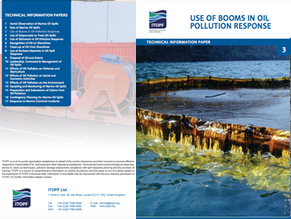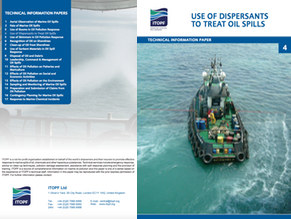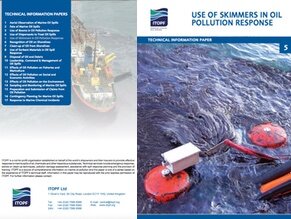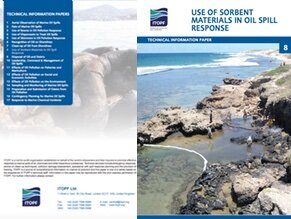Response Techniques
Once oil is spilled at sea, it will naturally spread, fragment and disperse under the influence of wind, waves and currents.
For spills in coastal waters, the oil will often drift towards the shore and become stranded due to the action of waves and tides. In order to contain the oil at the spill site, recover the oil floating on the sea and clean-up any oil that might become stranded on the shore, there are a variety of techniques that can be employed. The prevailing weather and sea conditions, the characteristics of the oiled shoreline and the nature of the oil can all combine to pose challenges to any clean-up operation.
At-Sea Response

Several options are available to respond to oil at sea and can be considered in three broad strategies; containment and recovery, in-situ burning and dispersant application. The selection of the most appropriate strategy will depend on many factors, including; the response resources available, the national and local regulations on oil spill response, the spill scenario and the physical and ecological characteristics of the area impacted by the spill.
Shoreline Clean-Up and Response

The majority of ship-source oil spills occur close to the coast and, as a result, many spills result in contamination of shorelines. Oil reaching stranding on the shore can cause significant environmental and economic impacts and may also largely determine the political and public perception of the scale of the incident, as well as the over costs.
When oil does reach the shoreline, considerable effort may be required to clean the affected areas. It is therefore essential that comprehensive and well-rehearsed arrangements for shoreline clean-up are included in contingency plans. The techniques available for shoreline clean-up are relatively straightforward and do not normally require specialised equipment. However, inappropriate techniques and poor organisation can aggravate the impacts caused by the oil itself.
Explore Documents on Response Techniques
01. Observación aérea de derrames de hidrocarburos en el mar
Este Documento de Información Técnica ofrece asesoramiento y directrices para lograr un reconocimiento aéreo eficaz.
Categories: Fate of Oil Spills, Response Techniques, Planning & operations, Spill Response, Technical Information Paper (TIPS)
03. Uso de barreras en la respuesta a la contaminación por hidrocarburos
Este documento describe los principios de diseño de las barreras y los dos modos principales
de operación, concretamente el remolque por embarcaciones en el mar y el amarre en aguas
poco profundas o en aguas costeras.
Categories: Response Techniques, Containment & Recovery, Planning & operations, Technical Information Paper (TIPS)
04. Uso de dispersantes para el tratamiento de derrames de hidrocarburos
Este documento ofrece una descripción general sobre el uso y limitaciones de los dispersantes sobre hidrocarburos flotantes, al tratarse de una de las diversas opciones disponibles para la respuesta a derrames de hidrocarburos en el medio marino procedentes de buques.
Categories: Response Techniques, Dispersants, Technical Information Paper (TIPS)
05. Uso de skimmers en la respuesta a la contaminación por hidrocarburos
Este documento describe los requisitos fundamentales para el uso correcto de skimmers en las situaciones más probables que pueden encontrarse durante un derrame de hidrocarburos y debe leerse junto con otros documentos de ITOPF de esta serie, en particular, sobre el uso de barreras, técnicas de limpieza y desecho de hidrocarburos.
Categories: Response Techniques, Containment & Recovery, Planning & operations, Technical Information Paper (TIPS)
06. Reconocimiento de hidrocarburos en costas
En casos de derrames de gran volumen, el origen de los hidrocarburos varados puede ser
evidente, aunque su identificación puede resultar difícil cuando se trata de una pequeña cantidad
de hidrocarburos y se pide indemnización por daños o costes de limpieza. El objeto de este
documento es ayudar al lector a reconocer el tipo y la cantidad de hidrocarburos en diversas costas.
Categories: Response Techniques, Planning & operations, Technical Information Paper (TIPS)
07. L impieza de costas contaminadas por hidrocarburos
Este documento describe las técnicas habituales de limpieza de costas y ofrece asesoramiento
sobre las alternativas más adecuadas para cada etapa de las operaciones para diferentes
tipos de costas.
Categories: Response Techniques, Technical Information Paper (TIPS)
08. Uso de materiales adsorbentes en la respuesta a derrames de hidrocarburos
Este documento considera los tipos de adsorbentes y cómo emplearlos correctamente en una
respuesta. Debe leerse junto con otros documentos de ITOPF de esta serie, en particular,
sobre el uso de barreras, uso de skimmers, técnicas de limpieza de costas y desecho de
hidrocarburos y desechos.
Categories: Response Techniques, Technical Information Paper (TIPS)







